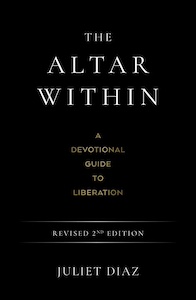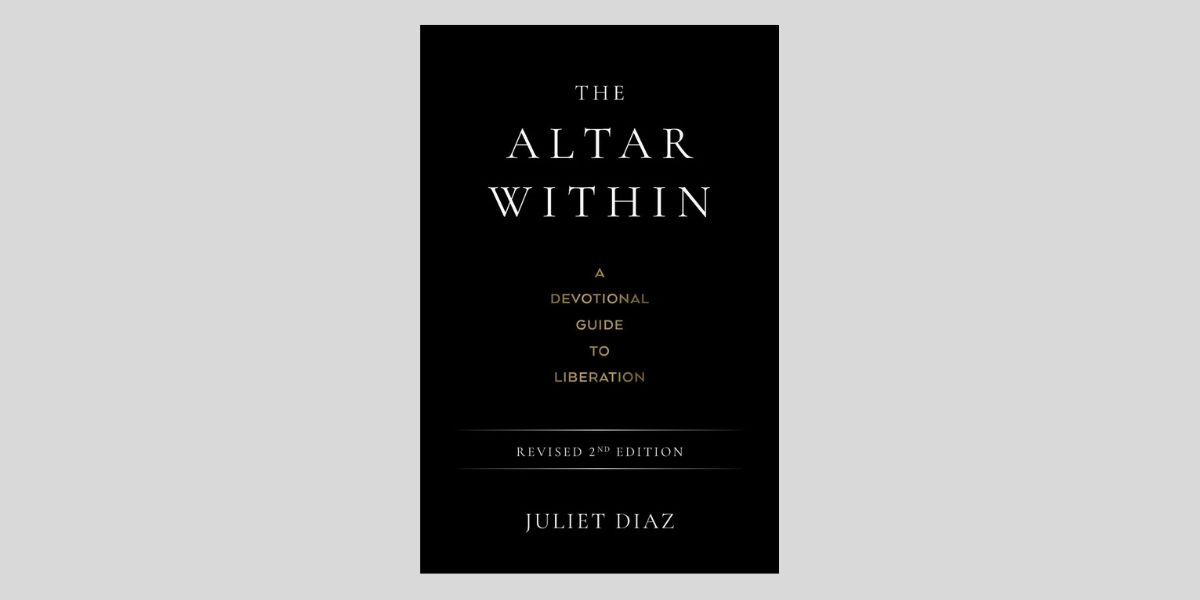
The Altar Within: A Devotional Guide to Liberation, Revised 2nd Edition, by Juliet Diaz
Rockpool Publishing,1923208624, 256 pages, September 2025
In this revised 2nd edition of The Altar Within, Indigenous Taíno Cuban-American author Juliet Diaz presents a radical devotional guide designed for inner and collective liberation. This inspiring read frames spirituality as a revolutionary act of healing deeply intertwined with justice, mutual aid, and ancestral wisdom. Within these pages, Diaz offers readers the opportunity to discover their sovereignty, finding a path that blends personal healing and community care.
“The journey towards building a life of sovereignty starts by recognizing the inner altar we each hold within, the center of our power, the seat of our wisdom, and the home of our deepest truths.”1
In an author’s note, Diaz describes how in this 2nd edition she changed the layout and flow of the book “with the intention of supporting those who are actively using this work in their personal and professional practices, in community settings, and within social movements.”2 There’s also an additional chapter for readers to delve deeper into the work of “inner and collective liberation”3.
Diaz has sectioned the book into four offerings, each one focusing on an aspect of liberation work. Within each offering are subsections that she refers to as devotionals. In a traditional mindset, one might liken these devotionals to chapters, however the amount of content within does make them feel like spiritual opportunities for readers to reflect on their own journey and integrate what comes up for themselves. I really like the wording Diaz chose for her content because it invites an openness when approaching the content; moving through each devotional is an act of offering oneself to a higher power for the greater good.
While each section differs in topic, there’s a seamless flow to the book that guides readers through shedding layers of their conditioning to discover the magic within. Diaz includes incantations, lessons, reflection prompts, writing prompts, and practices for readers to embody the information. This is definitely not a read-through-and-then-be-done-with-it type of book; it’s a text that readers can continually come back to as they learn, experience new things, and change internally as a result.
There’s even a whole devotional that honors self-discovery in which Diaz reminds readers it’s not about having a “static identity; it’s about connecting to a deeper essence, one that evolves as you grow.”4
This devotional is a great reminder that people will always be finding out new things about who they are, shifting their creative expression, discovering new gifts, and redefining their relationship with the past. This ultimately leads to uncovering more layers of the Self, and as a result, can be a journey that is celebrated and cherished rather than feared, controlled, or stifled. Continual reflection, exploring values, and redrawing boundaries is part of the process that Diaz aids readers in undertaking.
One of the best aspects of The Altar Within for me is how the text is very grounding, allowing for the wisdom we discover to find its home within the body and move outward from there. One of my favorite sections was about decolonializing wellness, where Diaz reminds readers “that wellness is not a luxury or privilege, but a right, tied to social, environmental, and cultural factors.”5
In this way, wellness becomes something relational, non-commodified, and Earth-centered. Diaz encourages readers to examine wellness in their own life, reassess beauty standards, and offers a practice called “Honoring Authentic Beauty Through Self-Connection”, which I highly enjoyed doing.
I also highly enjoyed the offering “Centering Collective Liberation”, in which Diaz teaches readers how to co-create community, engage in mutual aid, rebuild society through collective visioning, and protect our Earth through environmental justice. After moving through the first two offerings, focused more on internal work, this section really made me aware of how I could branch out and extend myself to make a difference in the world, which sometimes I think I forget I have the power to do.
The final offering, “Magic for the Revolution”, provides even more hands-on ways for readers to participate in societal change. Diaz writes:
“Revolution requires not only a willingness to envision a better world but also the courage to destroy what stands in its way.”6
Spells and rituals for doing things like cutting out the roots of white supremacy, dismantling capitalism, weakening systems of oppression, banishing colonialism, and calling in ancestors to support the uprising make for some potent magical workings. Luckily, Diaz has made them all quite accessible in regard to material needed and easy to do with step-by-step instructions. This offering also includes prayers and incantations for readers, if this is more their style, for inner libration, collective liberation, ancestors, and future generations.
Overall, The Altar Within stands out as a spiritually and politically resonant book, woven from ancestral memory, social justice, and honest self-care. Its strength lies in guiding readers toward self-worship—not in narcissistic terms, but as reclaiming one’s divinity amidst trauma, colonization, and cultural erasure. Diaz ties personal healing to collective liberation, offering a much-needed community-based, intersectional, and decolonial approach to magic and spirituality.
There’s a perfect balance of Diaz’s raw, honest, and grounding writing style that guides readers through acknowledging the shadows of the individualistic, colonial, capitalistic, predatory and oppressive systems of the Western world that have had a hugely detrimental effect on so many people worldwide. She holds space for readers as they acknowledge how far off course society has gotten and awakening to what can be done both personally and collectively to rebuild a society that is based on equity, justice, and love.
Like all great teachers, Diaz gets readers thinking for themselves. She unveils these uncomfortable truths without preaching or shaming others into believing them. The many prompts, practices, and rituals offered are for the reader to move at their own pace in this process. Unpacking shame, acknowledging ancestral trauma, overcoming spiritual by-passing, are tough things to do on your own. Diaz understands this wholeheartedly, and it’s clear this book was written for readers to know they are not alone and do have the power to face these things.
As someone who spent the morning fretting about current events in the United States, it was such a relief to remember I could do something proactive for myself and my community: reading The Altar Within. This book would resonate most with those who are seeking support in being an activist/advocate, looking to decolonize their spiritual path, longing for connection between their personal healing and community care, and feeling ready to do the inner and outer work to create a more inclusive, loving, and healthy world for the future.
“Our innate magic is amplified when we unlearn the conditioning of oppressive systems and reconnect with our authentic selves. By shedding layers of colonialism, capitalism,and white supremacy, we reclaim the sovereignty of our Spirit.”7
Alanna Kali is an astrologer, numerologist, and pioneer spirit that loves to explore life through the lens of depth psychology. She has a passion for studying the humanities and social trends. Her academic work is centered upon reuniting body, mind, and spirit through eco-psychology. She loves reading, spending time in nature, and travel.
